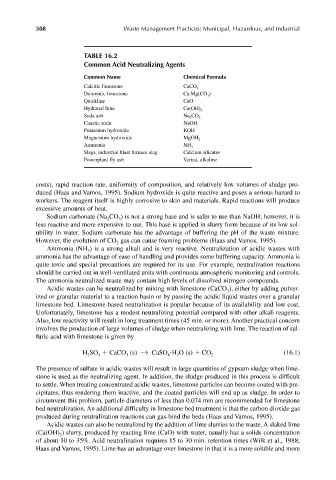Page 537 - Materials Chemistry, Second Edition
P. 537
CAT3525_C16.qxd 1/27/2005 12:42 PM Page 508
508 Waste Management Practices: Municipal, Hazardous, and Industrial
TABLE 16.2
Common Acid Neutralizing Agents
Common Name Chemical Formula
Calcitic limestone CaCO 3
Dolomitic limestone Ca·Mg(CO )
3
Quickline CaO
Hydrated lime Ca(OH) 2
Soda ash Na CO 3
2
Caustic soda NaOH
Potassium hydroxide KOH
Magnesium hydroxide MgOH 2
Ammonia NH 3
Slags, industrial blast furnace slag Calcium silicates
Powerplant fly ash Varied, alkaline
costs), rapid reaction rate, uniformity of composition, and relatively low volumes of sludge pro-
duced (Haas and Vamos, 1995). Sodium hydroxide is quite reactive and poses a serious hazard to
workers. The reagent itself is highly corrosive to skin and materials. Rapid reactions will produce
excessive amounts of heat.
Sodium carbonate (Na CO ) is not a strong base and is safer to use than NaOH; however, it is
2
3
less reactive and more expensive to use. This base is applied in slurry form because of its low sol-
ubility in water. Sodium carbonate has the advantage of buffering the pH of the waste mixture.
However, the evolution of CO gas can cause foaming problems (Haas and Vamos, 1995).
2
Ammonia (NH ) is a strong alkali and is very reactive. Neutralization of acidic wastes with
3
ammonia has the advantage of ease of handling and provides some buffering capacity. Ammonia is
quite toxic and special precautions are required for its use. For example, neutralization reactions
should be carried out in well-ventilated units with continuous atmospheric monitoring and controls.
The ammonia-neutralized waste may contain high levels of dissolved nitrogen compounds.
Acidic wastes can be neutralized by mixing with limestone (CaCO ), either by adding pulver-
3
ized or granular material to a reaction basin or by passing the acidic liquid wastes over a granular
limestone bed. Limestone-based neutralization is popular because of its availability and low cost.
Unfortunately, limestone has a modest neutralizing potential compared with other alkali reagents.
Also, low reactivity will result in long treatment times (45 min. or more). Another practical concern
involves the production of large volumes of sludge when neutralizing with lime. The reaction of sul-
furic acid with limestone is given by
H SO CaCO (s) → CaSO ·H O (s) CO 2 (16.1)
2
4
2
4
3
The presence of sulfate in acidic wastes will result in large quantities of gypsum sludge when lime-
stone is used as the neutralizing agent. In addition, the sludge produced in this process is difficult
to settle. When treating concentrated acidic wastes, limestone particles can become coated with pre-
cipitates, thus rendering them inactive, and the coated particles will end up as sludge. In order to
circumvent this problem, particle diameters of less than 0.074 mm are recommended for limestone
bed neutralization. An additional difficulty in limestone bed treatment is that the carbon dioxide gas
produced during neutralization reactions can gas-bind the beds (Haas and Vamos, 1995).
Acidic wastes can also be neutralized by the addition of lime slurries to the waste. A slaked lime
(Ca(OH) ) slurry, produced by reacting lime (CaO) with water, usually has a solids concentration
2
of about 10 to 35%. Acid neutralization requires 15 to 30 min. retention times (Wilk et al., 1988;
Haas and Vamos, 1995). Lime has an advantage over limestone in that it is a more soluble and more

